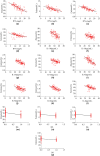The relationship between IFN-γ, IL-10, IL-6 cytokines, and severity of the condition with serum zinc and Fe in children infected with Mycoplasma pneumoniae
- PMID: 39291283
- PMCID: PMC11406141
- DOI: 10.1515/med-2024-0987
The relationship between IFN-γ, IL-10, IL-6 cytokines, and severity of the condition with serum zinc and Fe in children infected with Mycoplasma pneumoniae
Abstract
Objective: To explore the relationship between cytokines such as interferon γ (IFN-γ), interleukin-10 (IL-10), and interleukin-6 (IL-6), as well as the severity of the condition, and serum zinc (Zn) and Fe levels in children with Mycoplasma pneumoniae infection.
Methods: A simple random sampling method was used to select 108 children with Mycoplasma pneumoniae infection admitted to the hospital from January to December 2022 as the study subjects. Collect demographic data such as gender, age, and course of disease from all patients, as well as inflammatory cytokines (InCs) such as IFN-γ, IL-10, and IL-6, the severity of the condition, and serum trace element information such as Zn, Fe, calcium (Ca), and potassium (K) from all patients. Spearman correlation analysis was used to examine the relationship between IFN-γ, IL-10, IL-6, severity of illness, and Zn, Fe, Ca, K in children infected with Mycoplasma pneumoniae. Additionally, receiver operating characteristic (ROC) curve analysis was used to test the predictive efficacy of Zn, Fe, Ca, and K on the severity of the patient's condition.
Results: This study included 108 children infected with Mycoplasma pneumoniae, of whom 6 had clinical data missing >10% and were all excluded. Finally, 102 complete clinical data were collected, with a data recovery efficiency of 94.44%. The differences in IFN-γ, IL-10, IL-6 levels, severity of the condition, as well as Zn, Fe, Ca, K levels among children of different ages, disease courses, body mass, and body temperature showed P < 0. 05. Spearman correlation analysis showed that the levels of IFN-γ, IL-10, IL-6, and severity of the condition in children with Mycoplasma pneumoniae infection were negatively correlated with Zn, Fe, Ca, and K (ρ = -0.319 to -0.827, P < 0.05). The ROC curve analysis results indicate that Zn, Fe, Ca, and K can all be used as indicators to predict the severity of the patient's condition (AUC = 0.710-0.759, P < 0.05).
Conclusion: There is a close relationship between InCs and the severity of the condition in children with Mycoplasma pneumoniae and serum trace elements. Therefore, clinical attention should be paid to monitoring the serum trace element levels of children, and reasonable measures should be taken to regulate them to accelerate the progress of disease treatment.
Keywords: Mycoplasma pneumoniae infection; inflammatory cytokines; serum trace elements; severity of the illness.
© 2024 the author(s), published by De Gruyter.
Conflict of interest statement
Conflict of interest: The authors state no conflict of interest.
Figures





Similar articles
-
The predictive values of soluble B7-DC in children with refractory mycoplasma pneumoniae pneumonia.Transl Pediatr. 2023 Mar 31;12(3):396-404. doi: 10.21037/tp-23-86. Epub 2023 Mar 27. Transl Pediatr. 2023. PMID: 37035403 Free PMC article.
-
[Value of autotaxin in predicting refractory Mycoplasma pneumoniae pneumonia in children and its correlation with inflammatory cytokines].Zhongguo Dang Dai Er Ke Za Zhi. 2022 Jul 15;24(7):765-770. doi: 10.7499/j.issn.1008-8830.2203030. Zhongguo Dang Dai Er Ke Za Zhi. 2022. PMID: 35894191 Free PMC article. Chinese.
-
Clinical value of monitoring cytokine levels for assessing the severity of mycoplasma pneumoniae pneumonia in children.Am J Transl Res. 2024 Aug 15;16(8):3964-3977. doi: 10.62347/OUPW3987. eCollection 2024. Am J Transl Res. 2024. PMID: 39262706 Free PMC article.
-
Serum Tumor Necrosis Factor-α and Interferon-γ Levels in Pediatric Mycoplasma pneumoniae Pneumonia: A Systematic Review and Meta-Analysis.Can Respir J. 2018 Sep 10;2018:8354892. doi: 10.1155/2018/8354892. eCollection 2018. Can Respir J. 2018. PMID: 30275916 Free PMC article.
-
Cytokines and refractory mycoplasma pneumoniae pneumonia in children: a systematic review.Minerva Pediatr (Torino). 2024 Apr;76(2):259-267. doi: 10.23736/S2724-5276.23.07158-6. Epub 2023 May 8. Minerva Pediatr (Torino). 2024. PMID: 37155205
References
-
- Yan C, Xue G, Zhao H, Feng Y, Li S, Cui J, et al. Molecular and clinical characteristics of severe Mycoplasma pneumoniae pneumonia in children. Pediatr Pulmonol. 2019;54(7):1012–21. - PubMed
-
- Qu J, Chen S, Bao F, Gu L, Cao B. Molecular characterization and analysis of mycoplasma pneumoniae among patients of all ages with community-acquired pneumonia during an epidemic in China. Int J Infect Dis. 2019;83:26–31. - PubMed
-
- Krafft C, Christy C. Mycoplasma pneumonia in children and adolescents. Pediatr Rev. 2020;41(1):12–9. - PubMed
-
- Li J, Fu Y, Jing W, Li J, Wang X, Chen J, et al. Biomarkers of Mycoplasma pneumoniae pneumonia in children by urine metabolomics based on Q Exactive liquid chromatography/tandem mass spectrometry. Rapid Commun Mass Spectrom: RCM. 2022;(5):36. - PubMed
LinkOut - more resources
Full Text Sources
